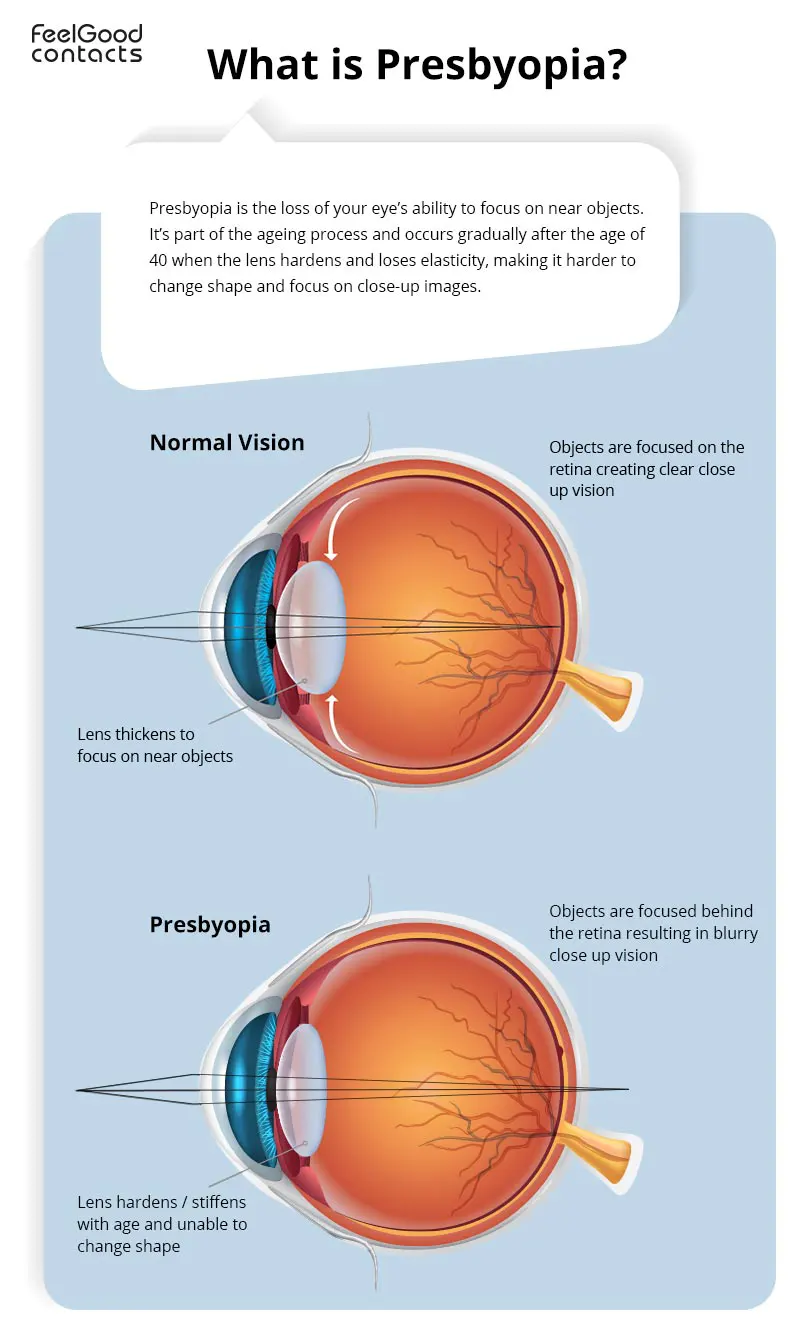Presbyopia is a condition that diminishes the eye's ability to focus on close-up objects. It usually occurs from about the age of 40 and is the most common form of near vision loss. Those who have presbyopia generally find that when they try to read or focus on small details, their vision becomes blurry.

Presbyopia is a common form of eyesight deterioration; it’s a condition that many people struggle with as they age. Nevertheless, it is a natural part of the ageing cycle. Contact lenses, glasses or monovision laser eye surgery can correct presbyopia.
Most people will develop presbyopia, even if they’ve never had a vision problem before. Even people who are short-sighted will notice that their near vision blurs when they wear their usual glasses or contact lenses to correct distance vision.
Fortunately, people with presbyopia who wish to wear contacts instead of bifocal glasses, progressive lenses (varifocal) or even reading glasses can opt to wear multifocal contact lenses.
What are the symptoms of presbyopia?
A typical symptom of presbyopia is difficulty reading smaller text, especially in low light conditions. You may also experience eye strain while reading, as well as headaches and blurry vision when changing viewing distance.
You should get an eye exam and speak to your optician if you experience any of the following symptoms:
- Sudden hazy or blurred vision
- Trouble seeing things up close
- Double vision
- You feel the need to hold reading material farther away to make letters appear clear
- If you experience headaches after reading or doing a task that requires close-up work and long periods of concentration
These symptoms may be worse if you are in dim lighting or experiencing fatigue. You may also experience symptoms of dry eye as you age. This can often be treated with eye drops.
Causes of presbyopia
The eye’s lens which sits behind the iris (the coloured part of the eye) focuses light onto the retina so that we can see. It does this by changing shape and allows us to see objects clearly, up close and in the distance. When we are young, the lens is flexible and able to do this with ease.
As we get older, after the age of 40 the lens becomes harder and less elastic. This hinders its ability to change shape as easily which makes it harder to focus on tasks that are close-up. As a result, the eye focuses light behind the retina rather than on it when looking at close objects. It’s considered a refractive error, along with short-sightedness, long-sightedness and astigmatism.
Risk factors of presbyopia
- Age – most people experience presbyopia to some degree after the age of 40
- Medical conditions - including diabetes, multiple sclerosis and cardiovascular diseases can cause premature presbyopia
- Drugs - such as antidepressants, antihistamines and diuretics are associated with early presbyopic symptoms
You should seek medical advice immediately if you are on any of these medications and experience symptoms of presbyopia.
Can you reverse presbyopia?
While presbyopia is a natural part of the ageing process and can’t be prevented or reversed, it can be corrected with glasses, contact lenses or laser eye surgery. Progressive lenses are an excellent choice for those who struggle to see near and far. If presbyopia is left uncorrected, it can result in eye strain and headaches.
Treatment for presbyopia
There are many treatments available for presbyopia including contact lenses, glasses, refractive surgery, and corneal inlays.
Contact lenses for presbyopia
There are two types of contact lenses for correcting presbyopia; multifocal contact lenses and monovision contacts.
Multifocal contact lenses are the most common way of correcting presbyopia. They work differently from glasses as with Multifocal glasses, the user needs to move their head and eyes to see clearly.
Multifocal contact lenses for presbyopia are available as daily, two weekly or monthly lenses, depending on your preference. They come as both soft lenses and as rigid gas permeable lenses.
There are two main types of multifocal contact lens designs. The most common is a set of concentric circles of lens powers prescribed for various viewing distances. There are also blended designs, which keep both the near and distance prescriptions close to the centre of your eye and mimic a natural viewing experience by correcting the specific points of aberration in your eyes.
Monovision contact lenses correct one eye for distance vision and the other for near vision.
Reading glasses
You can wear reading glasses as you age to correct presbyopia. You can also get glasses with bifocal lenses or purchase varifocal glasses.
Varifocal glasses feature three zones to look through. One for near vision, one for intermediate and one for distance vision. This allows for seamless transitioning at all distances. They are also referred to as progressive lenses or multifocal lenses.
Bifocal glasses feature just two different prescriptions within the lens for near and distance vision. You will notice a visible line on these lenses. This marks the separation between the distant and reading sections of the glasses.
Refractive surgery
In addition to contact lenses and glasses, refractive surgery can also offer clearer vision and is a more permanent option. There are many different types of refractive surgeries which can change the shape of your cornea so that your vision is improved in the non-dominant eye.
Before considering refractive surgery, it is important to speak to your eye care practitioner about the possible side effects.
Corneal inlays
Corneal inlays are another way to treat presbyopia. These are implants which are inserted into the cornea with a surgical procedure which is minimally invasive. They have an opening at the centre which allows focused light to enter so that you can see nearby objects. This procedure is more common in America.
Quick links:
A guide to blurry vision
Are there age limits on wearing contact lenses?
Do I need an eye test?
Disclaimer: The advice in this article is for informational purposes only and does not replace medical care or an in-person check-up. Please check with an eyecare professional before purchasing any products or remedies. For information on our article review process, please refer to our Editorial Policy.

 Offers
Offers Account
Account
 Favorite
Favorite
 Basket
Basket

 OFFERS
OFFERS

















